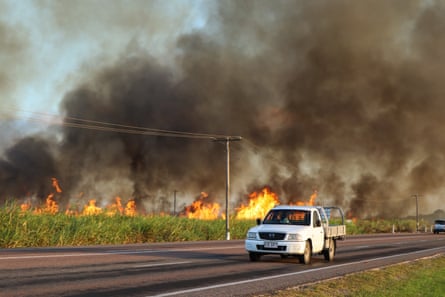As the sun sets over the Burdekin south of Townsville, an eruption of smoke stretches across the horizon. Torched cane fields force a flurry of fauna into a frenzied escape, only to get picked off by circling birds of prey. The firestorm is over in minutes, covering the district in a sprinkle of silt known as “Burdekin snow”.
The spectacle, which has become a symbol of this north Queensland region, is a pre-harvest burn of unwanted excess from the sugarcane crop. But as environmental and health concerns mount, and the lucrative opportunities of the sustainable economy become more apparent, the days of cane field burning may be numbered.
“It’d be good if we didn’t have to burn at all,” says the Burdekin cane grower Phillip Marano. “I would love nothing better than to be able to cut green. I can tell you that.”
Cane farmers in the region have been setting their fields on fire for decades despite the practice being largely discarded by most of the industry. Growers insist that tropical conditions make the burns economically necessary for harvesting due to the density of the crop and subsequent “cane trash”.
The practice has come under fire in other parts of the world for its effect on air quality and the surrounding environment. A recent study in Florida found that two to three people die prematurely each year because of exposure.
“The effects of smoke from burning sugarcane crops are pretty well established – the pollution consists of hundreds of different chemicals,” says Dr Fay Johnston from the Australian centre for air pollution, energy and health research.
“That’s a lot of inflammation in your lungs, you can feel it’s irritating on your eyes and throat when you are there. If you’re healthy, you can usually get away with it and recover. But if you’ve got an underlying health issue, particularly something like asthma or lung disease, it can be serious.”
Live air quality monitoring by the Queensland government consistently records the Burdekin town of Ayr as having one of the highest densities of “airborne particles less than 10 micrometres in diameter” in the state.
Despite burning sugarcane for the past three decades, Marano insists the effects of pollution are the least of his worries, saying they took all the “necessary precautions”. His focus is on the need to economically diversify his crops and support the ongoing battle against climate change.
“We can’t leave the trash on the ground. We have to get rid of it … we’re looking at ways of, obviously increasing revenue by using that trash but also supporting the fight against climate change in any way we can,” he says.

As part of the B green project, Marano and a group of farmers are currently in the research and development phase of a project seeking effective and commercially viable methods to turn cane crop excess into biofuels.
“The time has never been better for us to look at renewables. Because there is a push worldwide, people are interested in renewables, with the government setting targets, which I don’t believe we can meet with wind and solar alone,” Marano says.
The director of the Canegrowers Burdekin group, Owen Menkens, says companies are now “prepared to dump millions” into the biofuel industry. He sees the opportunity as a win-win for the environment and an industry that has long grappled with a volatile marketplace.
“We can’t keep relying on a world price that goes up and down. That’s why we started looking at other options – because we just want to shore up our business.”
after newsletter promotion
‘Unfairly’ burdened
Menkens and Marano claim the current state government regulations protecting water and environmental quality around the Great Barrier Reef catchment have “unfairly” burdened farmers.
“My farming practices didn’t change at all to become accredited. It’s a matter of proving that you’re following the laws,” Menkens says. “A lot of regulations are based on the fact that government assumes that farmers are dumb and that we do the wrong thing all the time.”
Marano says while there has been strong government interest in getting projects like his off the ground, there is still a lack of funding for early research.
“The trouble is, because we’re at the initial stages, it’s difficult to get funding. Once we get to the second stage where we’ve done the pre-feasibility, it seems like there’s a lot more funding opportunities.”
Both growers believe more thorough government support based on funding innovation would be required to get projects off the ground and help the industry transition.
A spokesperson for the Queensland Department of Environment and Science points out policymakers have conducted “extensive consultation” with agricultural bodies including the Canegrowers group.
“The Queensland government has invested more than $156m in programs to help farmers improve their practices, including direct funding over $14m since 2012 for the Smartcane Best Management Practice (BMP) program,” they say.
This article was amended on 26 September 2022. An earlier version referred to the Burdekin being north of Townsville, when south was meant. It also reported growers arguing that “subtropical conditions” make the burns necessary; while this was an expression heard, the Burdekin is a tropical region. It was further amended on 23 January 2023 to refer to birds of prey rather than vultures, which are not present in Australia.
